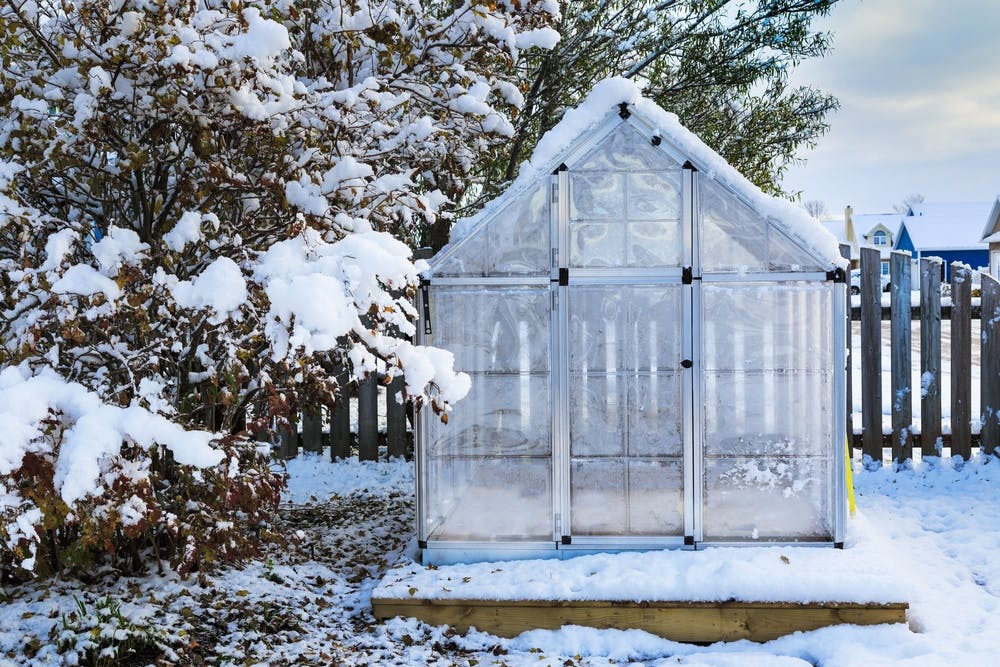How To Use A Greenhouse In Winter
 Every bit edible gardening continues to go more than mainstream, some of your clients may have opted to utilize a greenhouse to grow their veggies instead of raised beds.
Every bit edible gardening continues to go more than mainstream, some of your clients may have opted to utilize a greenhouse to grow their veggies instead of raised beds.
If this is the instance, they may be under the impression they won't be able to grow anything during the wintertime due to the long, cold nights causing temperatures to drop. However, this sheltered spot for plants doesn't accept to go dormant if they follow these tips from you.
Let the sunshine in
If the contractor was smart about the site and space planning of the greenhouse when it was congenital, then the structure should already be in a location that is free from shading from trees or other buildings. But when the sun'southward trajectory is lower in the heaven, other obstacles could create shadows, so brand sure the greenhouse is getting as much sunlight as possible.
Add together thermal mass
Ane of the easiest and least expensive options for warming greenhouses in the winter is to create a thermal mass or heat sink. These are objects that absorb estrus during the day and release information technology during the chilly nighttime hours. It will enhance the temperature by a caste or two and it can make all the departure.
A pop method of creating a thermal mass is placing containers of water in the greenhouse. For smaller greenhouses, capped one-gallon plastic jugs filled three-quarters total of water tin be placed throughout the greenhouse among the plants. The jugs can be painted black or blackness food coloring can be added to the water to increase estrus absorption.
For larger spaces, 55-gallon barrels painted black and filled with water can be placed in areas of direct dominicus. They will release the absorbed energy over the dark as well.
Employ a germination mat
If your client is mostly wanting to apply their greenhouse over the winter to become a head offset on their jump plants, a formation mat can serve their needs nicely. These mats help decrease production time by maintaining optimal root-zone temperature and increase the growth rates in the early stages of a establish's life cycle.
Cover up
Customers tin become as elaborate or as simple as they desire when it comes to covering plants during particularly cold nights to provide extra degrees of warmth. Tarps, horticultural fleece, row covers or sheets tin all assistance hold moisture in, merely remind clients to keep the covers off the plants themselves and to remember to remove them during the twenty-four hour period, as the humidity level tin get also high.
Create some compost
For customers who already have a pile of compost, moving it in to the centre of the greenhouse tin be a win-win, as it protects the compost from the elements and is warmer. This allows the process to speed upwards, while raising the temperature of the greenhouse as it breaks materials down. The optimal location for the pile is in the center of the greenhouse, only if this isn't feasible, it can be placed elsewhere and withal provide warmth. Too, come springtime the homeowner will have a pile of black golden readily available.
This alternative heating method may not be ideal if your customer doesn't know much about composting, or doesn't similar the thought of having a compost pile in the eye of the greenhouse. This option should be skipped if the greenhouse is i that is connected to the house, as they can attract mice and rats in the winter.
Add together insulation
Believe it or non, chimera wrap has another purpose other than protecting fragile packages and providing entertainment for the easily tickled. Attaching a layer of bubble wrap to the interior walls of the greenhouse can reduce heat loss and block winter drafts. Horticultural bubble wrap insulation can be found at garden centers and is UV stabilized and has larger bubbles, only traditional bubble wrap can suffice in a pinch.
Install a heater
Probably the most obvious choice when it comes to warming a greenhouse is simply installing some heaters, but these tin be expensive to run and the oestrus can rapidly dissipate when the heater is turned off. At that place are space heaters designed specifically for greenhouses, and propane heaters are a good pick if your customer doesn't want to accept to run extension cords to the greenhouse. It is of import to accept fans also to distribute the warm air throughout the space.
If using an electric heater, be sure to check the cords and connections to make sure they aren't frayed or worn. Ventilation is very important for controlling carbon monoxide levels and to prevent overheating the space, which is rare in the wintertime but even so possible in warmer climates.
How To Use A Greenhouse In Winter,
Source: https://www.totallandscapecare.com/business/article/15041327/how-to-keep-a-greenhouse-warm-in-the-winter
Posted by: aldereteyetwall.blogspot.com


0 Response to "How To Use A Greenhouse In Winter"
Post a Comment